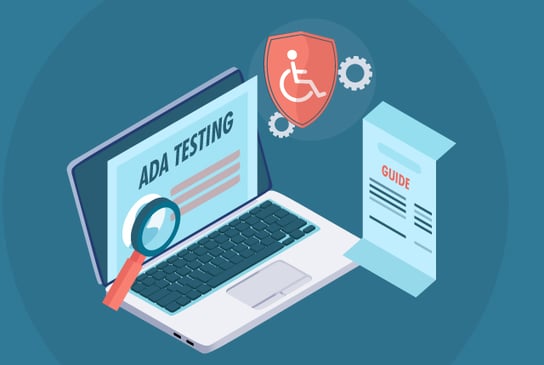
In today's digital age, it's important to ensure that websites and applications are accessible to everyone, regardless of their abilities. Failure to achieve this not only violates the Americans with Disabilities Act (ADA), but also results in potential legal action, public relations issues, and additional costs of making changes to meet compliance regulations.
Accessibility testing is a vital part of any software because you want as many people as possible to be able to use what you’re launching. However, when you don’t have the tools and people for the job, ensuring accessibility compliance can be easier said than done. This guide sheds light on the importance of ADA testing, its requirements, and the best practices to ensure compliance.
What Is ADA Testing?
ADA testing means auditing your software to see if it meets the regulations stated in the law. According to the ADA, any public accommodation, like websites, should not discriminate when it comes to disability.
In 2019, Mary Conner filed a lawsuit against Beyonce because her website was not accessible to the visually impaired. The case gained a lot of attention because of the defendant, but it also shed light on services that were lacking in ADA compliance testing. According to the complaint, some barriers prevented full use of the website — these included a lack of navigation, labels, and alt-text.
A similar case occurred a few years ago with Domino’s Pizza. Like Beyonce’s website, Domino’s website had no provisions for the blind. While the initial resolution favored Domino’s, it was later overturned in 2019. Interestingly, it happened in the same year that light was shed on cases that violated ADA accessibility testing. The Court of Appeals overturned the initial decision, stating that Domino’s website violated the ADA ruling.
What Are the Requirements for ADA-compliance?
Complying with the ADA has to do with following the Web Content Accessibility Guidelines (WCAG). There are guidelines set by WCAG 2.0, which all companies should follow. It’s a three-tiered grading system:
- A: The website or app is only accessible to some users
- AA: The website or app is accessible to nearly all users
- AAA: The website or app is accessible to everyone
The goal is to at least satisfy AA to avoid any compliance issues. Failure to do so would lead to a potential lawsuit, PR issues, and additional costs of changing your technology to make it compliant.
One of the best ways to make sure you’re ADA-compliant is by having a checklist. Following are the points that you must consider:
- All media files should have an alt tag
- Hyperlinks should have descriptive text
- Online forms should be descriptive HTML
- You have navigation links on your website that allow users to navigate faster
- The text should have proper headings
- PDF files should be accessible
- Videos should have transcripts/subtitles
- There must be enough color contrast on your website
- Fonts should be accessible
- Audio files should have captions
- All tables should have complete information for headers, rows, and cells
- Call-to-action buttons should have a label and name
- You have an accessibility policy page
- Your website should support keyboard navigation
- Contact information is easy to find
- Check WCAG to verify compliance
- Automate testing through self-healing mechanisms
A self-healing mechanism identifies any products that need to evolve for accessibility. They can detect and automatically update attributes for websites and applications. Some people call them automation for automation. You can find software in the market with automation for Web UI, accessibility, and more. It works within a similar framework to this:
- The software identifies any objects that do not comply with current accessibility standards
- The mechanism analyzes and identifies if there’s anything it can do to improve the object, like an update or transfer
- It logs the information of what it detected and what it did
- You can view these reports to see if the automation was successful or if you need to make any other adjustments
Ultimately this process leads to fewer mistakes and saves a lot of time that would’ve been spent testing. Because it tests automatically, a self-healing mechanism allows your team to discover the root cause and address it directly.
Types of ADA Compliance Testing
There are two main types of ADA compliance testing used by all testers: manual testing and automated testing. Both have their advantages and disadvantages.
-
Manual Testing
Manual testing is the traditional style of validating accessibility and ADA compliance. One uses their skills and knowledge to verify different aspects of the website or application. For example, they may check the website as if they’re visitors and see if they encounter any problems. It’s effective because it emulates a visitor’s experience using the site or programme.
However, this process is very time-consuming — identifying the different errors and problems will take numerous tests. Since there is the possibility of human error, there may even be a chance that no one discovers an issue until the product is released to the public.
-
Automated Testing
One of the more recent advancements is automated testing which uses computers to verify different aspects of the website. A company will set parameters for a programme to check, and it will do so quickly and precisely. One of the best things about automated testing is that it’s incredibly fast. You’ll save a lot of time, giving yourself more opportunities to fix any errors it detects.
While automated testing is efficient, it doesn’t have the thoroughness that manual testing provides. Computers don’t take things from a user’s standpoint, meaning they might miss some accessibility issues. You’re able to check certain variables like HTML and alt tags, however, you won’t be able to analyze data from a user’s perspective.
Common Problems in Accessibility Testing
There are several problems that testers often encounter when checking for ADA compliance. Learning about them will give you more insight into the things that people often overlook.
- Text contrast issues: The text’s level of brightness and color should contrast with the website's or application's background. The words should also be legible, no matter the screen size.
- Image alternative text: Developers often miss alt text for images. These are the descriptive labels that help the visually impaired.
- Empty links and buttons: Links and buttons take up a lot of space on a website and shouldn’t be empty. A lot of users with disabilities rely on buttons to help them navigate on mobile devices.
- Improper heading: Text should have a heading hierarchy to help with navigation. H1 should be for the title. Other heading levels should define the structure of the text and remain consistent.
- Too many links: While links are good, too many of them can be a bad thing. It can clutter one’s screen and overload the senses. Too many of them make it difficult to navigate the website, reducing accessibility.
- Inaccessible documents: All linked documents within an app or website should be accessible. A broken link or missing file will equate to a negative user experience.
- Elements are not reachable through the Keyboard: This problem occurs when users are unable to access or navigate through a website or digital content using only a keyboard.
- Elements are not focus-able on Navigation: This problem occurs when users are unable to easily identify or navigate to specific elements on a website or digital content using keyboard navigation.
- Elements are not recognized by Screen Reader Tool: This problem occurs when screen readers are unable to properly recognize and interpret certain elements or content on a website, which can make it difficult or impossible for individuals with visual impairments to access and understand the content.
Best Tools for ADA Compliance Testing
Developers are always creating tools to help with ADA compliance testing. There are many out there, but some stand out from the rest. You can also find that professional ADA testing services have a set of tools they rely on for QA. Here are tools to help you with ADA website testing and more:
-
Color Contrast Tools
Color contrast tools are an important part of ADA testing, specifically for web accessibility. They are used to measure the contrast ratio between text and its background, to ensure that the text is legible and easy to read for people with visual impairments. These tools include:
- Color Contrast Analyzer: A tool you can use to determine if the text on a website is legible. It also checks for color contrast to ensure that visual elements on a website are easily discernible.
-
Screen Reader Tools
In ADA testing, screen reader tools are used to test the accessibility of websites and digital content for users who rely on screen readers. Screen readers can provide a way to test if web pages are accessible to people with visual impairments or other disabilities that prevent them from conventionally using a mouse or keyboard. These tools include:
- JAWS (Job Access With Speech): A popular screen reader developed by Freedom Scientific, JAWS is a widely used tool for accessing websites and other digital content by individuals with visual impairments.
- NVDA (Non-Visual Desktop Access): NVDA is a free and open-source screen reader that provides support for a wide range of applications, including web browsers, email clients, and office productivity tools.
- VoiceOver: A built-in screen reader for Apple's macOS and iOS operating systems, VoiceOver provides users with a comprehensive set of features for accessing digital content, including navigation controls, audio descriptions, and support for braille displays.
- Orca: A free and open-source screen reader developed for the GNOME desktop environment, Orca provides users with support for a wide range of applications and digital content, including web pages, emails, and instant messaging clients.
-
Alt Tag Checker Tools
These tools are used to ensure that all images on a website have appropriate alternative text that describes the image in a meaningful and accurate way. The tool scans each image on the website and checks if alt text has been assigned to it. If an image does not have alt text, or if the alt text is empty or inaccurate, the alt tag checker will flag it as an accessibility issue that needs to be addressed. These tools include:
- WAVE: Uses a tool that analyzes web content and annotates any issues it finds. It also shows recommendations on what to do to fix these problems.
- Tenon: A tool for ADA 508 compliance testing and WCAG 2.0 verification. There are several different APIs you can use for tests.
- Axe Dev Tools: This free browser extension provides a suite of accessibility testing tools, including an Alt Text Checker that allows users to quickly check the accessibility of image descriptions across a website.
Conclusion
ADA testing is essential because it allows your app or website to remain accessible to the majority of users. The lack of ADA compliance will cause disability discrimination issues to arise, which will cause a breach of the ADA. A breach will result in penalties and even a lawsuit as seen in the case of Domino’s Pizza. The good news is that professionals can help with testing, making sure that you’re not missing any crucial accessibility features.
QASource can help with both manual and automated testing. Our team has worked with hundreds of companies to verify accessibility compliance at the highest level possible. Contact us today to learn more about the services we offer.

